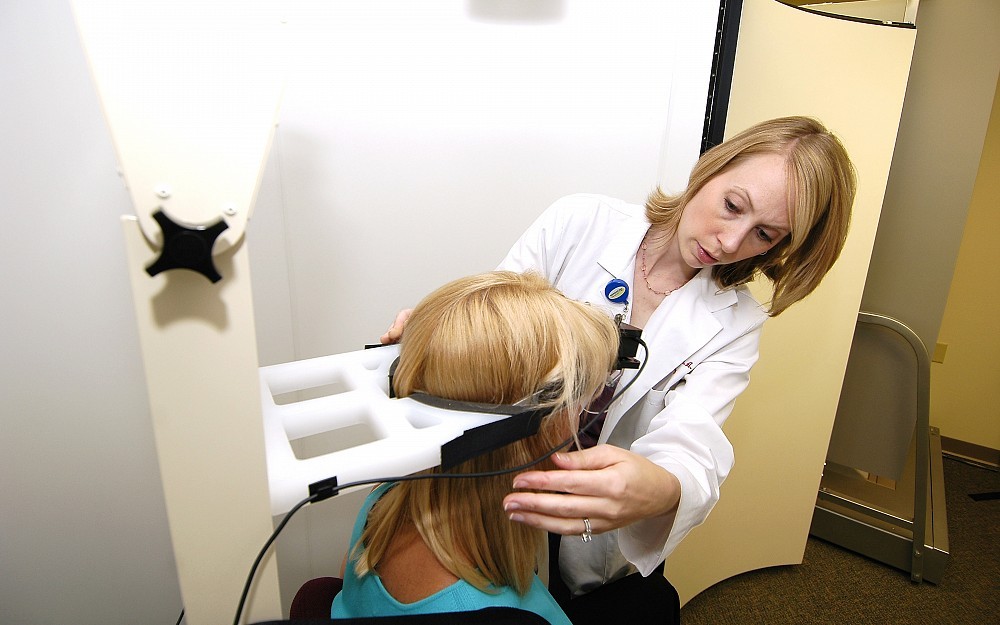
UC HEALTH LINE: Dizziness, Fatigue May Be Sign of Balance Disorder
CINCINNATIJust
about everything you do in your daily lifewhether its walking,
driving a car or brushing your teethrequires balance.
For
most people balance is so instinctive they dont think about ituntil
dizziness or disorientation signals that something has gone wrong.
And when that happens, UCs Balance Center is one of few comprehensive care facilities in the area available to diagnose and treat the problem.
Maintaining balance depends on three complex processes, says Julie Honaker, director of audiology in the UC Department of OtolaryngologyHead and Neck Surgery: the sensory systems ability to accurately determine the bodys position relative to the environment (standing up, for example), the brains ability to process that information, and the coordinating movement of the muscles and joints.
The bodys balance sensors include the eyes, the sense of touch, and the inner earwhere calcium carbonate otolith particles and fluid inside three paired canals stimulate hair cells to generate senses of forward, backward and vertical motion in the head.
The Balance Center offers various tests that examine all the balance sensory systems and a persons ability to execute coordinated movements, both voluntary and involuntary, to maintain balance.
Already one of the best equipped of its kind, UCs Balance Center recently updated equipment and added several new tests, all of which provide a more comprehensive look at the inner ear balance system than standard technology. They are:
· A rotational chair: UC is one of the first comprehensive balance centers in the area to offer this test. Patients are seated in a chair that rotates at different speeds to measure their eye movements. The chair features multiple testing options that focus on different aspects of balance function.
· Platform posturography: This series of tests measures how well patients can maintain their balance while the walls and floor of the booth in which they are standing are gradually moved.
· VEMP (vestibular evoked myogenetic potential): This technique measures responses from the saccule, one of the otolith organs in the inner ear, to sound stimulation, including high-intensity acoustic stimuli, clicks and low-frequency tones.
So many conditions can cause dizziness and disorientation, says Honaker. Were like detectives when we evaluate and test people for balance disorders, because of all the conditions that must be ruled out as the cause. Thats why were really excited to add this equipment to our centerit gives us more in-depth options for whats causing a patients balance issues.
People can develop balance problems because of inner ear conditions, head injury, stroke or other neurological issues, she explains.
Balance disorders can really disrupt a persons life, adds Ravi Samy, MD, assistant professor of otolaryngology. They can cause fatigue, shorten the attention span, disrupt sleep patterns and increase the risk of falling, making it difficult to do everyday tasks.
Balance problems also increase with age, and Honaker, currently studying the risk and fear of falling in the elderly, hopes to establish a program for at-risk patients.
Were an aging population, so its important to offer safety and counseling tips to help those at risk of falling, she says. Im hoping to develop a multidisciplinary approach, which would include primary care, geriatric and neurology physicians among others.
For more information on balance disorders, visit www.netwellness.org, a collaborative health-information Web site staffed by Ohio physicians, nurses and allied health professionals, or call (513) 475-8453 to schedule an appointment at the Balance Center.

Ravi Samy, MD, assistant professor of otolaryngology

Julie Honaker, director of audiology in the UC Department of Otolaryngology Head and Neck Surgery

The UC Balance Center recently added a rotational chair which features multiple testing options that focus on different aspects of balance function.

Julie Honaker, director of audiology, Department of Otolaryngology Head and Neck Surgery, stands in front of the Balance Center's new rotational chair.
Tags
Related Stories
UC study: Brain organ plays key role in adult neurogenesis
July 2, 2024
The University of Cincinnati has published research in the Proceedings of the National Academy of Sciences that found the choroid plexus and cerebrospinal fluid play a key role in maintaining a pool of newly born neurons to repair the adult brain after injury.
Put down that beer; it's not a tanning lotion
July 1, 2024
The University of Cincinnati's Kelly Dobos joined WVXU's Cincinnati Edition to discuss what's fact and what's myth when it comes to sunscreen use, different kinds of sunscreen and a social media recommendation to use beer on your skin to help get a tan.
Cincinnati researchers want to know if MRIs can work better
June 28, 2024
WVXU and the Cincinnati Business Courier highlighted a new collaboration between the University of Cincinnati College of Medicine, UC Health GE HealthCare, JobsOhio, REDI Cincinnati and Cincinnati Children’s to create an MRI Research and Development Center of Excellence located on UC’s medical campus.
